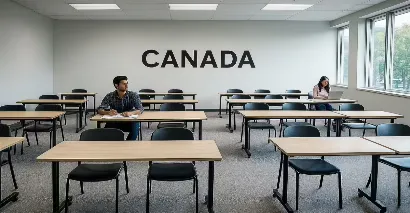Key Highlights
- The Great Canadian Student Slowdown: A Near 60% Plunge
- A Structural Shift, Not a Seasonal Blip
- Ottawa's Policy Hammer: Deliberate Measures for "Sustainability"
- The Economic and Academic Ripple Effect
- The Global Pivot: Where Are Indian Students Going?
- Looking Ahead: Re-calibrating Canada's Education Model
- Conclusion
The allure of the "Maple Dream" has abruptly faded for hundreds of thousands of prospective international students. Canada’s international education sector, a robust engine of economic growth and cultural exchange, is reeling from a massive shock. New student arrivals plummeted by nearly 60% in the first eight months of 2025, a dramatic reversal of fortune that reflects a deliberate, structural policy shift by the Canadian government. This slowdown is not a market correction but a direct result of Ottawa's aggressive measures to address mounting concerns over housing shortages and strain on local resources, signalling a fundamental change in the country's immigration strategy.
The Great Canadian Student Slowdown: A Near 60% Plunge
The numbers released by Immigration, Refugees and Citizenship Canada (IRCC) paint a clear and stark picture of the decline. Between January and August 2025, the cumulative new study-permit arrivals totalled 89,430, a dizzying drop from the 221,940 registered during the same period in 2024. This massive downturn of 132,510 students represents a nearly two-thirds collapse in the flow of fresh talent and tuition revenue into the country. The data confirms that the government's strategy is having its intended, if painful, effect on the volume of newcomers.
Also Read: Canada Unveils New Rules for Canada Immigration to Welcome Diverse Talent
The Stark Statistics of Decline
The statistics highlight the severity of the arrival freeze, demonstrating a sector in rapid contraction.
The sheer scale of the change is alarming, particularly when isolating the most recent data point:
-
August 2025: New study permit arrivals were 45,380.
-
August 2024: New study-permit arrivals were 79,795.
This single-month comparison shows a sharp 43.1% year-over-year decline. The cumulative figures, however, confirm a systemic issue, reflecting the sustained, negative pressure applied by the new regulations across the year. The education system must now contend with a vastly reduced intake for the immediate future.
A Structural Shift, Not a Seasonal Blip
The contraction extends beyond just new entrants and indicates a deep, structural decline in the overall student population. While the focus is often on new arrivals, the total number of international students residing in Canada has also shrunk considerably.
As of August 2025, the total student population stood at 802,425, a decrease of over 217,620 from the 1,020,045 recorded a year prior. This represents an over 21% overall reduction, meaning that one in five international students who were studying in Canada last year is no longer present. The drop includes a 21% decline in students holding only study permits and a 21.9% fall for those with both study and work permits, confirming a widespread demographic change.
Also Read: The Canada-India Diplomatic Row: Latest Insights on Immigration, Visas, and Indian Students
Ottawa's Policy Hammer: Deliberate Measures for "Sustainability"
The significant fall in student numbers is not attributable to market forces or decreased demand, but rather to a series of deliberate and calculated policy changes implemented by Ottawa. The IRCC describes this comprehensive policy mix as a necessary move toward "sustainability" for the education and housing sectors.
The decline is not accidental but a result of decisive governmental intervention aimed at stabilising high housing costs and easing infrastructure strain.
The Cap on Study Permits
The most direct mechanism for reducing student numbers is the implementation of a national study-permit cap. This restriction directly controls the volume of approved applications, allocating quotas to provinces and institutions.
This measure is explicitly designed to curtail the rapid growth seen in the preceding years, ensuring that educational institutions and local infrastructure have the capacity to support the incoming population. The caps create immediate bottlenecks in the application process, leading to delays and outright rejections for many hopeful applicants, thereby engineering the massive drop in arrivals.
Raising the Financial Bar
Another significant deterrent is the sharp increase in the proof-of-funds requirements for a study permit application. The government substantially raised the minimum amount of money an applicant must prove they have available to support themselves in Canada.
This change places a heavier financial burden on students, particularly those from middle-income countries like India, making the cost of entry significantly higher. The elevated financial threshold acts as a filter, excluding applicants who might otherwise qualify academically but cannot meet the steepened mandatory savings requirement.
Restricting Work Pathways
Crucially, the government also moved to narrow the scope of post-graduation opportunities. Changes included tightening eligibility for Post-Graduation Work Permits (PGWPs) and placing severe restrictions on spousal open work permits.
Historically, the ability for international students to work and eventually apply for permanent residency via the PGWP, and for their spouses to work, made Canada highly attractive. By limiting these pathways, Ottawa has diminished the Return on Investment (ROI) of a Canadian education, discouraging many who viewed it as a long-term immigration strategy.
Also Read: Carney’s Immigration Mandate: Canada’s New Path for 2025 and Beyond
The Economic and Academic Ripple Effect
The sudden drop in student arrivals has immediate, far-reaching consequences across Canada's financial and educational landscapes, threatening to destabilise both public and private sectors.
The financial and academic impact extends far beyond the lecture halls, affecting entire local economies reliant on the student population.
Strain on University Finances
Canadian universities and colleges have grown increasingly dependent on the higher tuition fees paid by international students to balance their budgets and fund operations. The dramatic drop in enrollment is now straining these institutional budgets.
Many institutions are facing acute fiscal pressure, leading to practical steps such as implementing hiring pauses, delaying research projects, and potentially even considering the closure of certain programs. This financial vulnerability exposes a significant over-reliance on international tuition, which has become a subsidy for domestic education and research.
Impact on Local Economies
International students are not just tuition payers; they are significant economic contributors who drive demand across multiple sectors. Their presence supports local services, driving sales in retail, utilising public transport, and consuming housing.
The departure of over 200,000 total students translates to reduced consumption in local markets, impacting the livelihoods of small businesses and service providers. Sectors like housing, retail, and transportation will inevitably feel the pinch, transforming a perceived immigration problem into a local economic recession in specific student-heavy cities.
The Fate of Smaller Institutions
The structural changes are having a disproportionately severe effect on smaller colleges and private institutions that were most heavily reliant on global student recruitment. These colleges often operated on razor-thin margins, with international tuition forming the majority of their income.
Unlike large, well-endowed universities, many smaller colleges lack the financial reserves to absorb a 60% drop in new student intake. This vulnerability puts them at high risk of insolvency, program shutdowns, and potentially catastrophic failure, leading to uncertainty for both current and future students.
The Global Pivot: Where Are Indian Students Going?
India is by far the most affected nation by Canada's policy shift, as Indian students have historically constituted the single largest demographic in the Canadian international student body, accounting for approximately 39% of the total population. This concentration means the policy changes have hit Indian aspirants the hardest.
As the largest demographic affected, Indian students are now actively exploring more welcoming shores and re-evaluating their study-abroad options.
The End of the "Maple Dream"
For many Indian students, the "Maple Dream" was built on the promise of a high-quality education coupled with a clear, reliable pathway to permanent residency. The recent policy changes have introduced significant uncertainty and higher costs.
The new restrictions—higher proof-of-funds and limited post-study work options—have shattered the perceived reliability of the Canadian system. The increased risk and complexity, coupled with rising expenses, are making students and their families reassess whether the investment in a Canadian education remains worthwhile given the now-turbulent environment.
The Rise of Alternative Destinations
In response to the tightened Canadian market, Indian students are actively exploring more straightforward and cost-effective study destinations. Other countries are quickly stepping in to capitalise on Canada's self-imposed contraction.
Nations such as Germany, the United Kingdom (UK), and Australia are emerging as attractive alternatives, offering perceived advantages like lower overall costs, simpler visa procedures, and, in some cases, clearer post-study work routes. This swift pivot demonstrates a global competition for talent and highlights that Canada's loss is a gain for its competitors.
Long-Term Damage to Canada's Brand
The sudden and sweeping nature of the policy changes risks inflicting long-term damage on Canada’s reputation as a reliable and welcoming destination for international education. Building trust takes years, but it can be eroded in months.
Future students may view Canadian education as unstable and subject to unpredictable policy shifts. Rebuilding this international brand recognition and trust will require years of consistent, transparent, and student-friendly policies, making the recovery of student numbers a protracted challenge.
Also Read: A Comprehensive Guide to Express Entry Canada
Looking Ahead: Re-calibrating Canada's Education Model
The path forward for Canada requires a careful balancing act between managing internal pressures and sustaining its role as a global education leader. The government faces a difficult challenge in recalibrating the entire model.
Balancing Immigration and Infrastructure
The core justification for the caps was the pressure placed on Canadian infrastructure, particularly housing, by high immigration levels. Ottawa’s primary challenge is now to find an equilibrium.
The government must develop and implement coordinated strategies that address the housing supply deficit while ensuring that future, carefully controlled immigration levels contribute positively to the economy. This delicate balancing act demands long-term planning that avoids sudden, destabilising policy shocks to the system.
The Call for Differentiated Policies
The education sector is advocating for more nuanced, differentiated policies rather than the current one-size-fits-all approach. Critics argue that blanket caps unfairly penalise legitimate public institutions while failing to target fraudulent private colleges.
Future policy could involve setting different enrollment targets for public universities versus private vocational schools, or by allowing different caps based on a province's infrastructure capacity. Such tailored regulations would support quality education providers while selectively reducing student numbers in oversaturated areas.
Conclusion
The nearly 60% drop in new international student arrivals in 2025 marks a watershed moment for Canada. Driven by deliberate government action—including permit caps, stricter financial requirements, and narrower work pathways—this sharp contraction signals a necessary, yet costly, re-evaluation of Canada's rapid growth model. While aimed at enhancing "sustainability" and easing housing pressures, the policy changes have severely impacted university budgets, local economies, and Canada’s standing among international students, particularly those from India. Moving forward, Ottawa must stabilise the sector by implementing measured, differentiated policies that balance economic contribution with infrastructure capacity. The long-term success of the Canadian education brand depends on a strategic, reliable, and transparent approach to attracting global talent. Visit TerraTern now to learn more.








